Gayoung Lee
Enhancing Creative Generation on Stable Diffusion-based Models
Mar 30, 2025Abstract:Recent text-to-image generative models, particularly Stable Diffusion and its distilled variants, have achieved impressive fidelity and strong text-image alignment. However, their creative capability remains constrained, as including `creative' in prompts seldom yields the desired results. This paper introduces C3 (Creative Concept Catalyst), a training-free approach designed to enhance creativity in Stable Diffusion-based models. C3 selectively amplifies features during the denoising process to foster more creative outputs. We offer practical guidelines for choosing amplification factors based on two main aspects of creativity. C3 is the first study to enhance creativity in diffusion models without extensive computational costs. We demonstrate its effectiveness across various Stable Diffusion-based models.
DECOR:Decomposition and Projection of Text Embeddings for Text-to-Image Customization
Dec 12, 2024Abstract:Text-to-image (T2I) models can effectively capture the content or style of reference images to perform high-quality customization. A representative technique for this is fine-tuning using low-rank adaptations (LoRA), which enables efficient model customization with reference images. However, fine-tuning with a limited number of reference images often leads to overfitting, resulting in issues such as prompt misalignment or content leakage. These issues prevent the model from accurately following the input prompt or generating undesired objects during inference. To address this problem, we examine the text embeddings that guide the diffusion model during inference. This study decomposes the text embedding matrix and conducts a component analysis to understand the embedding space geometry and identify the cause of overfitting. Based on this, we propose DECOR, which projects text embeddings onto a vector space orthogonal to undesired token vectors, thereby reducing the influence of unwanted semantics in the text embeddings. Experimental results demonstrate that DECOR outperforms state-of-the-art customization models and achieves Pareto frontier performance across text and visual alignment evaluation metrics. Furthermore, it generates images more faithful to the input prompts, showcasing its effectiveness in addressing overfitting and enhancing text-to-image customization.
A Simple Early Exiting Framework for Accelerated Sampling in Diffusion Models
Aug 12, 2024Abstract:Diffusion models have shown remarkable performance in generation problems over various domains including images, videos, text, and audio. A practical bottleneck of diffusion models is their sampling speed, due to the repeated evaluation of score estimation networks during the inference. In this work, we propose a novel framework capable of adaptively allocating compute required for the score estimation, thereby reducing the overall sampling time of diffusion models. We observe that the amount of computation required for the score estimation may vary along the time step for which the score is estimated. Based on this observation, we propose an early-exiting scheme, where we skip the subset of parameters in the score estimation network during the inference, based on a time-dependent exit schedule. Using the diffusion models for image synthesis, we show that our method could significantly improve the sampling throughput of the diffusion models without compromising image quality. Furthermore, we also demonstrate that our method seamlessly integrates with various types of solvers for faster sampling, capitalizing on their compatibility to enhance overall efficiency. The source code and our experiments are available at \url{https://github.com/taehong-moon/ee-diffusion}
Visual Style Prompting with Swapping Self-Attention
Feb 21, 2024Abstract:In the evolving domain of text-to-image generation, diffusion models have emerged as powerful tools in content creation. Despite their remarkable capability, existing models still face challenges in achieving controlled generation with a consistent style, requiring costly fine-tuning or often inadequately transferring the visual elements due to content leakage. To address these challenges, we propose a novel approach, \ours, to produce a diverse range of images while maintaining specific style elements and nuances. During the denoising process, we keep the query from original features while swapping the key and value with those from reference features in the late self-attention layers. This approach allows for the visual style prompting without any fine-tuning, ensuring that generated images maintain a faithful style. Through extensive evaluation across various styles and text prompts, our method demonstrates superiority over existing approaches, best reflecting the style of the references and ensuring that resulting images match the text prompts most accurately. Our project page is available https://curryjung.github.io/VisualStylePrompt/.
Sequential Data Generation with Groupwise Diffusion Process
Oct 02, 2023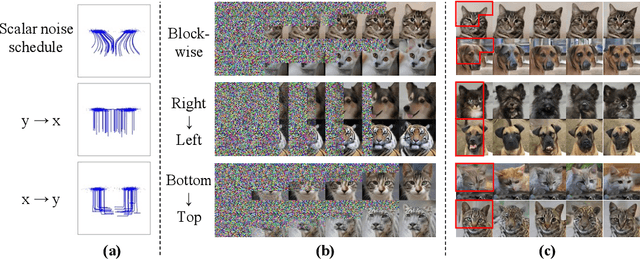
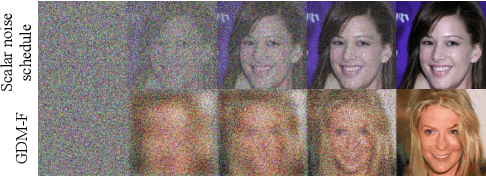

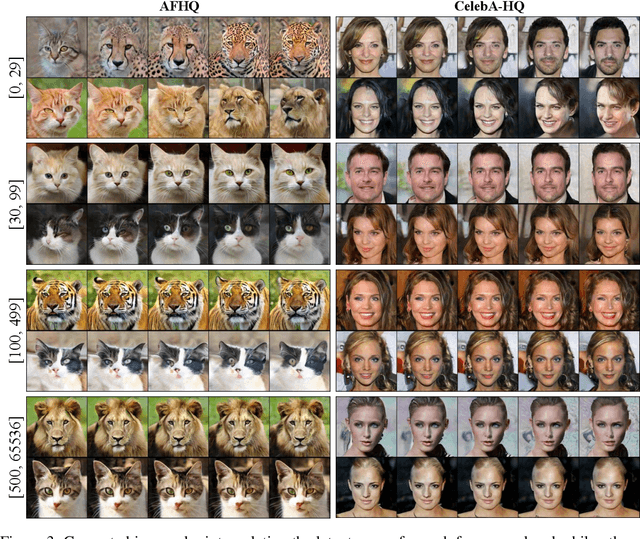
Abstract:We present the Groupwise Diffusion Model (GDM), which divides data into multiple groups and diffuses one group at one time interval in the forward diffusion process. GDM generates data sequentially from one group at one time interval, leading to several interesting properties. First, as an extension of diffusion models, GDM generalizes certain forms of autoregressive models and cascaded diffusion models. As a unified framework, GDM allows us to investigate design choices that have been overlooked in previous works, such as data-grouping strategy and order of generation. Furthermore, since one group of the initial noise affects only a certain group of the generated data, latent space now possesses group-wise interpretable meaning. We can further extend GDM to the frequency domain where the forward process sequentially diffuses each group of frequency components. Dividing the frequency bands of the data as groups allows the latent variables to become a hierarchical representation where individual groups encode data at different levels of abstraction. We demonstrate several applications of such representation including disentanglement of semantic attributes, image editing, and generating variations.
3D-aware Blending with Generative NeRFs
Feb 13, 2023Abstract:Image blending aims to combine multiple images seamlessly. It remains challenging for existing 2D-based methods, especially when input images are misaligned due to differences in 3D camera poses and object shapes. To tackle these issues, we propose a 3D-aware blending method using generative Neural Radiance Fields (NeRF), including two key components: 3D-aware alignment and 3D-aware blending. For 3D-aware alignment, we first estimate the camera pose of the reference image with respect to generative NeRFs and then perform 3D local alignment for each part. To further leverage 3D information of the generative NeRF, we propose 3D-aware blending that directly blends images on the NeRF's latent representation space, rather than raw pixel space. Collectively, our method outperforms existing 2D baselines, as validated by extensive quantitative and qualitative evaluations with FFHQ and AFHQ-Cat.
Generator Knows What Discriminator Should Learn in Unconditional GANs
Jul 27, 2022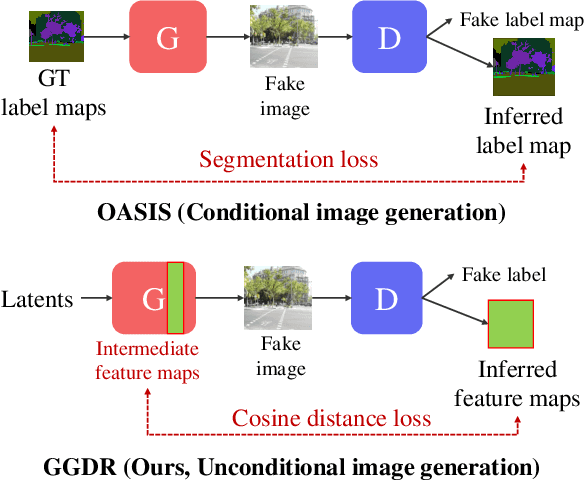
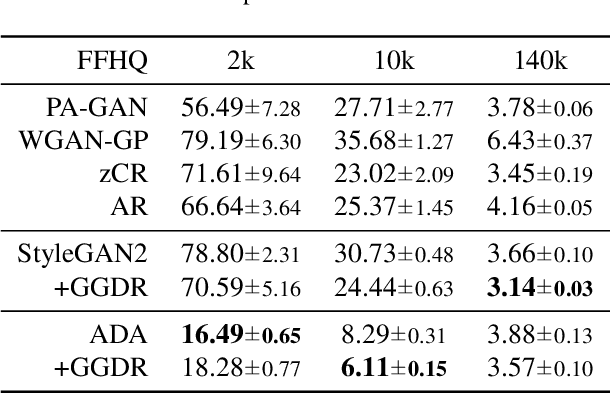
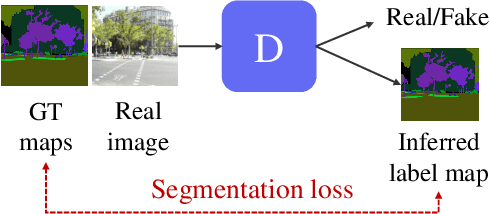
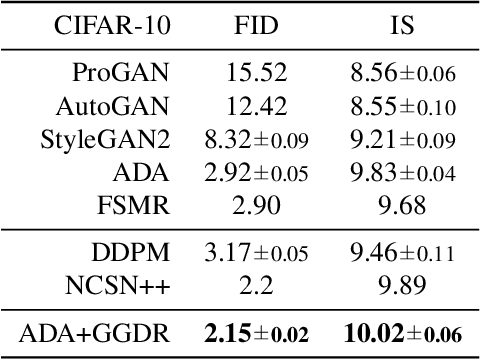
Abstract:Recent methods for conditional image generation benefit from dense supervision such as segmentation label maps to achieve high-fidelity. However, it is rarely explored to employ dense supervision for unconditional image generation. Here we explore the efficacy of dense supervision in unconditional generation and find generator feature maps can be an alternative of cost-expensive semantic label maps. From our empirical evidences, we propose a new generator-guided discriminator regularization(GGDR) in which the generator feature maps supervise the discriminator to have rich semantic representations in unconditional generation. In specific, we employ an U-Net architecture for discriminator, which is trained to predict the generator feature maps given fake images as inputs. Extensive experiments on mulitple datasets show that our GGDR consistently improves the performance of baseline methods in terms of quantitative and qualitative aspects. Code is available at https://github.com/naver-ai/GGDR
Memory Efficient Patch-based Training for INR-based GANs
Jul 09, 2022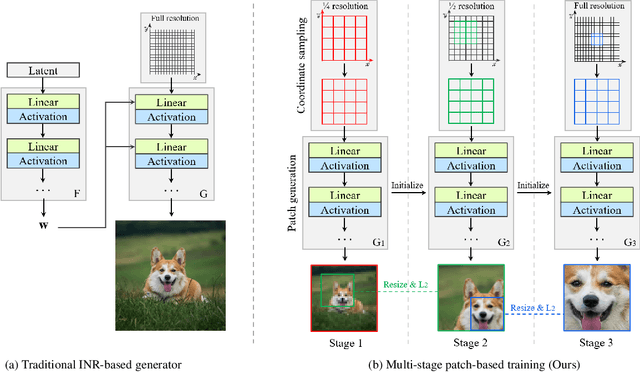

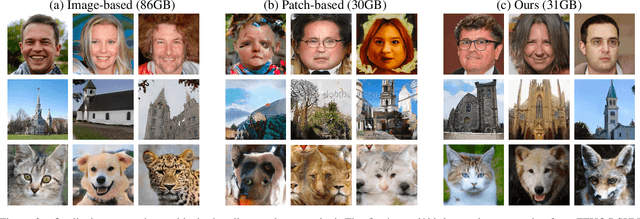
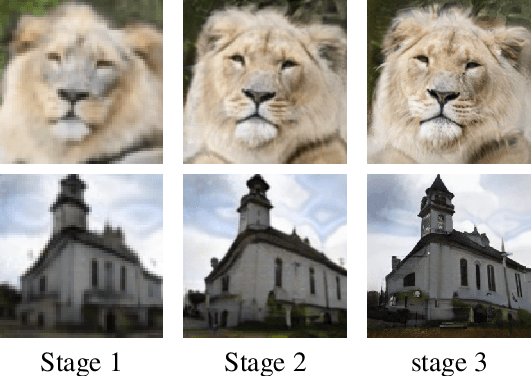
Abstract:Recent studies have shown remarkable progress in GANs based on implicit neural representation (INR) - an MLP that produces an RGB value given its (x, y) coordinate. They represent an image as a continuous version of the underlying 2D signal instead of a 2D array of pixels, which opens new horizons for GAN applications (e.g., zero-shot super-resolution, image outpainting). However, training existing approaches require a heavy computational cost proportional to the image resolution, since they compute an MLP operation for every (x, y) coordinate. To alleviate this issue, we propose a multi-stage patch-based training, a novel and scalable approach that can train INR-based GANs with a flexible computational cost regardless of the image resolution. Specifically, our method allows to generate and discriminate by patch to learn the local details of the image and learn global structural information by a novel reconstruction loss to enable efficient GAN training. We conduct experiments on several benchmark datasets to demonstrate that our approach enhances baseline models in GPU memory while maintaining FIDs at a reasonable level.
RewriteNet: Realistic Scene Text Image Generation via Editing Text in Real-world Image
Jul 23, 2021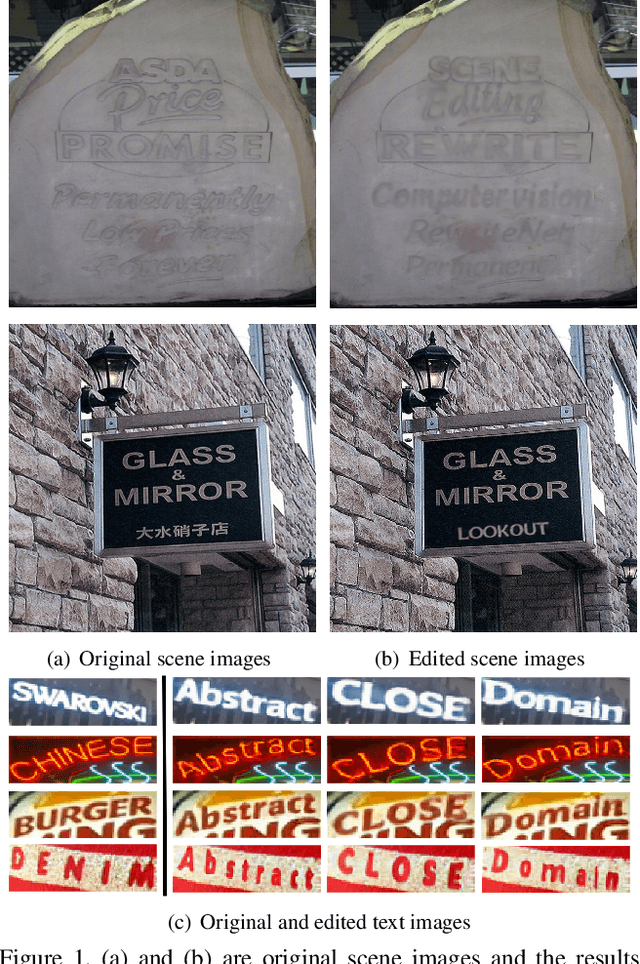
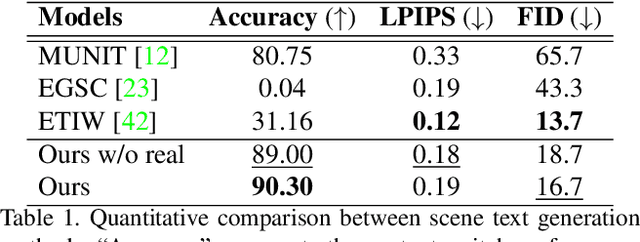
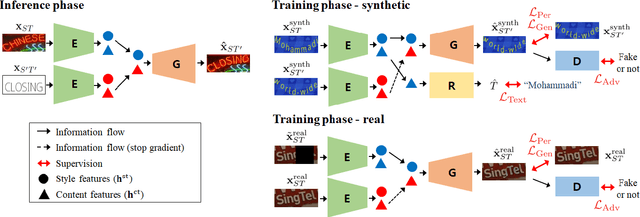
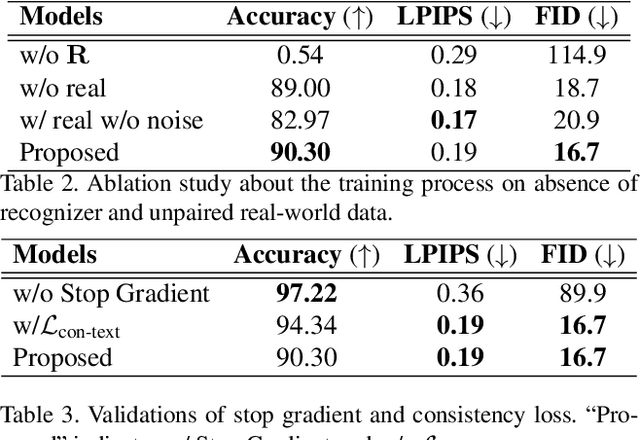
Abstract:Scene text editing (STE), which converts a text in a scene image into the desired text while preserving an original style, is a challenging task due to a complex intervention between text and style. To address this challenge, we propose a novel representational learning-based STE model, referred to as RewriteNet that employs textual information as well as visual information. We assume that the scene text image can be decomposed into content and style features where the former represents the text information and style represents scene text characteristics such as font, alignment, and background. Under this assumption, we propose a method to separately encode content and style features of the input image by introducing the scene text recognizer that is trained by text information. Then, a text-edited image is generated by combining the style feature from the original image and the content feature from the target text. Unlike previous works that are only able to use synthetic images in the training phase, we also exploit real-world images by proposing a self-supervised training scheme, which bridges the domain gap between synthetic and real data. Our experiments demonstrate that RewriteNet achieves better quantitative and qualitative performance than other comparisons. Moreover, we validate that the use of text information and the self-supervised training scheme improves text switching performance. The implementation and dataset will be publicly available.
Few-shot Compositional Font Generation with Dual Memory
May 21, 2020
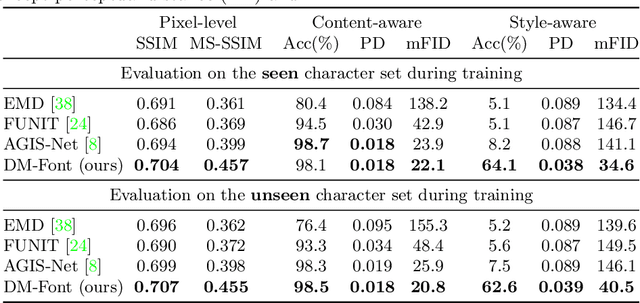

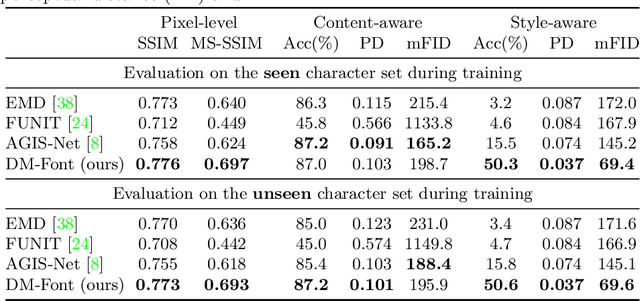
Abstract:Generating a new font library is a very labor-intensive and time-consuming job for glyph-rich scripts. Despite the remarkable success of existing font generation methods, they have significant drawbacks; they require a large number of reference images to generate a new font set, or they fail to capture detailed styles with a few samples. In this paper, we focus on compositional scripts, a widely used letter system in the world, where each glyph can be decomposed by several components. By utilizing the compositionality of compositional scripts, we propose a novel font generation framework, named Dual Memory-augmented Font Generation Network (DM-Font), which enables us to generate a high-quality font library with only a few samples. We employ memory components and global-context awareness in the generator to take advantage of the compositionality. In the experiments on Korean-handwriting fonts and Thai-printing fonts, we observe that our method generates a significantly better quality of samples with faithful stylization compared to the state-of-the-art generation methods in quantitatively and qualitatively.
 Add to Chrome
Add to Chrome Add to Firefox
Add to Firefox Add to Edge
Add to Edge